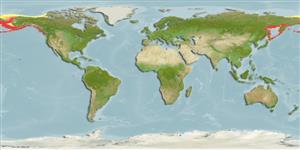分類 / Names
共通名の | 類義語 | Catalog of Fishes(部類, 種) | ITIS | CoL | WoRMS | Cloffa
>
Salmoniformes (Salmons) >
Salmonidae (Salmonids) > Salmoninae
Etymology: Salvelinus: Old name for char; it is the same root of german "saibling" = little salmon (Ref. 45335); malma: malma which is the the common name for this species in Kamchatka (Ref. 1998).
More on author: Walbaum.
Environment: milieu / climate zone / depth range / distribution range
生態学
海; 新鮮な水; 汽水性の 底生の漂泳性; 昇流魚 (Ref. 51243); 深さの範囲 0 - 200 m (Ref. 50550). Temperate; 4°C - 18°C (Ref. 13614); 75°N - 38°N, 127°E - 123°W
North America: Arctic and Pacific drainages from lower Mackenzie River in Northwest Territories, Canada to Puget Sound and Quinault River in Washington, USA (Ref. 86798). Northwest Pacific: Korea to Bering Sea (Ref. 2850).
Length at first maturity / サイズ / 重さ / 年齢
Maturity: Lm 23.5, range 12 - 21 cm
Max length : 127 cm TL オス/雌雄の選別がない; (Ref. 27436); common length : 37.5 cm TL オス/雌雄の選別がない; (Ref. 12193); 最大公表体重: 18.3 kg (Ref. 27436)
背面の脊椎 (合計): 0; 背鰭 (合計): 10-16; 肛門の骨 0; 臀鰭: 10 - 15. Body elongate, somewhat rounded, greatest body depth below dorsal fin. Head rather long. Pelvic fins with free-tipped fleshy appendage above its insertion. Caudal emarginate (Ref. 27547). Color varies with size, locality and habitat. Sea-run adults with back, upper head, and upper sides dark blue, the sides silvery to white. In freshwater populations, the back and upper sides are olive green to brown, the sides a paler color but bright red in spawning fish and at all times in some areas of Alaska, the underside white to dusky. The dorsal surface are marked with yellow, orange or red spots, more numerous and those along the lateral line smaller, than in arctic char. Spawning males, especially of anadromous populations, turn red on the ventral surface and tip of snout. The lower jaw, operculum and parts of the head are black, the back and sides turn olive-brown. The spots become more vivid orange-red, the pectoral and anal fins red-black with a white leading edge, the snout thickens and the lower jaw turns up. Females change less.
Occurs in deep runs and pools of creeks and small to large rivers; also in lakes and the sea (Ref. 5723, 86798). Lives in very clean mountain streams (Ref. 12218). Nerito-pelagic (Ref. 58426). Typically anadromous, but many populations are landlocked. Anadromous fish may spend 2-3 years at sea, evidently near shore, migrate upstream usually in fall, and spawn during spring (Ref. 86798). Young remain in streams for 3-4 years and feed on insects, leeches, snails, and salmon eggs (Ref. 1998) before entering brackish and salt water to feed on insects, fishes, and other invertebrates. Utilized fresh and eaten fried, broiled, and baked (Ref. 9988).
Life cycle and mating behavior
成熟 | 繁殖 | 放精 | 卵 | 生産力 | 幼生
Adults from the sea and lakes enter rivers to spawn. A female selects a nest site and begins to dig a redd while the male continues to court her and drive away intruding males. Upon completion of the redd, both drop into it and release eggs and sperm. This may be repeated several times before the eggs are covered by the female who swims along the edge of the of the redd, sweeping small pebbles and other particles into it with her tail and anal fin. Later, she may dig again and further cover the eggs while preparing a new nest (Ref. 27547). Breeding is an annual event for southern populations; occurring every second or third year in the Arctic (Ref. 27547). Males and females reportedly die after spawning (Ref. 12218).
Page, L.M. and B.M. Burr, 2011. A field guide to freshwater fishes of North America north of Mexico. Boston : Houghton Mifflin Harcourt, 663p. (Ref. 86798)
Human uses
水産業: 商業; ゲームフィッシュ: はい
より多くの情報
参考文献水産養殖水産養殖の紹介緊張遺伝子のElectrophoreses遺伝病気行列NutrientsMass conversion
用具
特記事項
XMLをダウンロードして下さい
インターネットの情報源
Estimates based on models
Preferred temperature (Ref.
123201): 0.2 - 8, mean 2.2 °C (based on 653 cells).
Phylogenetic diversity index (Ref.
82804): PD
50 = 0.5000 [Uniqueness, from 0.5 = low to 2.0 = high].
Bayesian length-weight: a=0.00589 (0.00399 - 0.00870), b=3.04 (2.92 - 3.16), in cm total length, based on LWR estimates for this species & (Sub)family-body (Ref.
93245).
栄養段階 (Ref.
69278): 4.4 ±0.6 se; based on diet studies.
回復力 (Ref.
120179): 低い, 4.5年~14年の倍増期間の最小個体群 (tm=3-5).
Prior r = 0.24, 95% CL = 0.15 - 0.39, Based on 1 stock assessment.
Fishing Vulnerability (Ref.
59153): High to very high vulnerability (70 of 100).
Nutrients (Ref.
124155): Calcium = 6.82 [4.19, 11.37] mg/100g; Iron = 0.282 [0.177, 0.452] mg/100g; Protein = 18.1 [16.8, 19.6] %; Omega3 = 1.08 [0.46, 2.78] g/100g; Selenium = 13.9 [4.8, 42.4] μg/100g; VitaminA = 22.3 [7.0, 74.9] μg/100g; Zinc = 0.523 [0.395, 0.693] mg/100g (wet weight);
